
Carry On is a British comedy franchise comprising 31 films, four Christmas specials, a television series and stage shows produced between 1958 and 1992. Produced by Peter Rogers, the Carry On films were directed by Gerald Thomas and starred a regular ensemble that included Sid James, Kenneth Williams, Charles Hawtrey, Joan Sims, Kenneth Connor, Peter Butterworth, Hattie Jacques, Terry Scott, Bernard Bresslaw, Barbara Windsor, Jack Douglas, and Jim Dale. The humour of Carry On was in the British comic tradition of music hall and bawdy seaside postcards. The success of the films led to several spin-offs, including four Christmas television specials (1969–1973), a 1975 television series of 13 episodes, a West End stage show and two provincial summer shows.
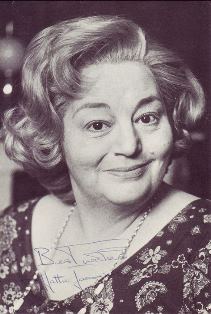
Hattie Jacques was an English comedy actress of stage, radio and screen. She is best known as a regular of the Carry On films, where she typically played strict, no-nonsense characters, but was also a prolific television and radio performer.
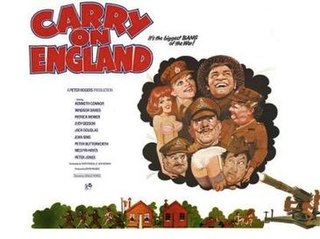
Carry On England is a 1976 British comedy film, the 28th release in the series of the original 30 Carry On films (1958–1978). It was released in October 1976 and featured Carry On regulars Kenneth Connor, Jack Douglas, Joan Sims and Peter Butterworth. It was the second and last Carry On film for Windsor Davies, Diane Langton and Peter Jones, as well as the fifth and last for Patricia Franklin and the eighth and last for Julian Holloway. Patrick Mower, Judy Geeson and Melvyn Hayes make their only appearances in a Carry On film. The film was followed by That's Carry On! in 1977.

Carry On at Your Convenience is a 1971 British comedy film, directed by Gerald Thomas and starring regulars Sid James, Kenneth Williams, Charles Hawtrey, Joan Sims, Hattie Jacques and Bernard Bresslaw and Kenneth Cope in the first of his two Carry On appearances. It was written by Talbot Rothwell and produced by Peter Rogers.
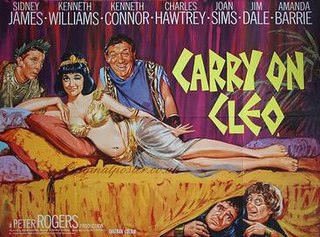
Carry On Cleo is a 1964 British historical comedy film, the tenth in the series of 31 Carry On films (1958–1992). Regulars Sid James, Kenneth Williams, Kenneth Connor, Charles Hawtrey, and Jim Dale are present and Connor made his last appearance until his return in Carry On Up the Jungle six years later. Joan Sims returned to the series for the first time since Carry On Regardless three years earlier. Sims would now appear in every Carry On up to Carry On Emmannuelle in 1978, making her the most prolific actress in the series. Jon Pertwee makes the first of his four appearances in the series. The title role is played by Amanda Barrie in her second and last Carry On. Along with Carry On Sergeant and Carry On Screaming!, its original posters were reproduced by the Royal Mail on stamps to celebrate the 50th anniversary of the Carry On series in June 2008. The film was followed by Carry On Cowboy 1965.

Carry On Up the Khyber is a 1968 British comedy film, the 16th in the series of 31 Carry On films (1958–1992). It stars Carry On regulars Sid James, Kenneth Williams, Charles Hawtrey, Joan Sims, Bernard Bresslaw and Peter Butterworth. It is the second of two Carry On film appearances by Wanda Ventham; and Roy Castle makes his only Carry On appearance, in the romantic male lead part usually played by Jim Dale.

Carry On Sergeant is a 1958 British comedy film about national service starring William Hartnell, Bob Monkhouse and Eric Barker; it is the first in the series of Carry On films, with 31 entries released from 1958 to 1992. The film was based on a play The Bull Boys by R. F. Delderfield and was adapted into a script by Norman Hudis with John Antrobus contributing additional material and replacing the conscripted ballet dancers of the novel with a married couple. It was directed by Gerald Thomas and produced by Peter Rogers, a partnership which would last until 1978. Actors in this film, who went on to be part of the regular team in the series, were Kenneth Williams, Charles Hawtrey, Hattie Jacques, Kenneth Connor and Terry Scott. The film was followed by Carry On Nurse 1959.

Carry On Nurse is a 1959 British comedy film, the second in the series of 31 Carry On films (1958–1992). Of the regular team, it featured Joan Sims, Kenneth Williams, Kenneth Connor and Charles Hawtrey, with Hattie Jacques and Leslie Phillips. The film was written by Norman Hudis based on the play Ring for Catty by Patrick Cargill and Jack Beale. It was the top-grossing film of 1959 in the United Kingdom and, with an audience of 10.4 million, had the highest cinema viewing of any of the "Carry On" films. Perhaps surprisingly, it was also highly successful in the United States, where it was reported that it played at some cinemas for three years. The film was followed by Carry On Teacher 1959.

Carry On Teacher is a 1959 British comedy film, the third in the series of 31 Carry On films (1958–1992). It was released at the Plaza Cinema in London on 3 September 1959. It features Ted Ray in his only Carry On role, alongside series regulars; Kenneth Connor, Charles Hawtrey, Kenneth Williams and Hattie Jacques. Leslie Phillips and Joan Sims make their second appearances in the series here, having made their debuts in the previous entry, Carry On Nurse. A young Richard O'Sullivan and Larry Dann – making the first of his four Carry On appearances – turn up as pupils. In 2023, Dann dedicated a chapter of his autobiography Oh, What A Lovely Memoir to share his memories of this production. The film was followed by Carry On Constable 1960.

Carry On Constable is a 1960 British comedy film, the fourth in the series of 31 Carry On films (1958–1992). It was released in February 1960. Of the regular team, it featured Kenneth Connor, Kenneth Williams, Charles Hawtrey, Joan Sims, and Hattie Jacques. Sid James makes his debut in the series here, while early regulars Leslie Phillips, Eric Barker, and Shirley Eaton also turn up, although Phillips did not appear again in the series for 32 years. It was the first "Carry On..." film to include some nudity with Connor, Hawtrey, Williams, and Phillips baring their behinds during a shower scene. The film was followed by Carry On Regardless 1961.

Carry On Regardless is a 1961 British comedy film, the fifth in the series of 31 Carry On films (1958–1992). The film revolves loosely around the activities of a job agency, 'Helping Hand', run by Sid James's character, Bert Handy. By now a fairly regular team was established with Sid James, Kenneth Connor, Charles Hawtrey, Joan Sims and Kenneth Williams all having appeared in previous entries. Hattie Jacques – who was also a regular – makes a cameo appearance during a hospital scene. "Professor" Stanley Unwin appears in a guest role, playing his trademark "gobbledegook" speaking act. It was the final appearance in the series for early regular Terence Longdon. Liz Fraser made her debut and appeared in a further three Carry On films. The film was followed by Carry On Cruising 1962.
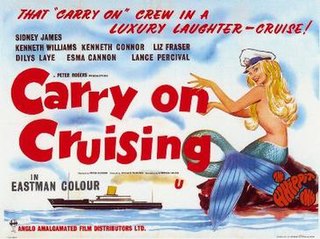
Carry On Cruising is a 1962 British comedy film, the sixth in the series of 31 Carry On films (1958–1992). It was based on an original story by Eric Barker. P&O – Orient Lines were thanked in the credits. Regulars Sid James, Kenneth Williams and Kenneth Connor appear in the film, whereas Joan Sims and Charles Hawtrey do not. Sims took ill shortly before filming began and was replaced by Dilys Laye, making her Carry On debut, at four days' notice. Hawtrey was dropped for demanding star billing, but returned for the next entry, making this the only entry during Hawtrey's 23-film run which he missed. Sims returned two years later in Carry On Cleo. Liz Fraser notches up the second of her four appearances here. Lance Percival makes his only appearance in the series in Carry On Cruising, playing the ship's chef, the role originally designated for Hawtrey. The Australian actor Vincent Ball also makes his first, of two, Carry On appearances. This was the last film to have its screenplay written by Norman Hudis. This film was notable for being the first in the series to be filmed in colour. The film was followed by Carry On Cabby 1963.
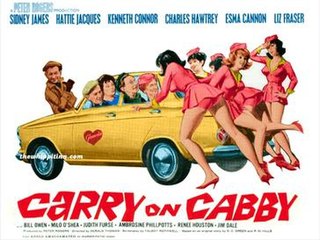
Carry On Cabby is a 1963 British comedy film, the seventh in the series of thirty-one Carry On films (1958–1992). Released on 7 November 1963, it was the first to have a screenplay written by Talbot Rothwell from a story by Dick Hills and Sid Green. Regulars Sid James, Hattie Jacques, Kenneth Connor and Charles Hawtrey are all present. Liz Fraser makes her third appearance and both Bill Owen and Esma Cannon make their final appearances. This was the first film in the series to feature Carry On regular Jim Dale, and the first not to feature Kenneth Williams in the cast. Williams turned down the role of Allbright due to what he considered an inferior script. The part was scaled down, and given to Norman Chappell.

Carry On Cowboy is a 1965 British comedy Western film, the eleventh in the series of 31 Carry On films (1958–1992). It was the first film to feature series regulars Peter Butterworth and Bernard Bresslaw. Series regulars Sid James, Kenneth Williams, Jim Dale, Charles Hawtrey and Joan Sims all feature, and Angela Douglas makes the first of her four appearances in the series. Kenneth Williams, usually highly critical of all the Carry on films he appeared in, called the film "a success on every level" in his diary, taking pride in its humour and pathos. The film was followed by Carry On Screaming! (1966).

Carry On Laughing is a British television comedy series produced in 1975 for ATV. Based on the Carry On films, it was an attempt to address the films' declining cinema attendance by transferring the franchise to television. Many of the original cast members were featured in the series.
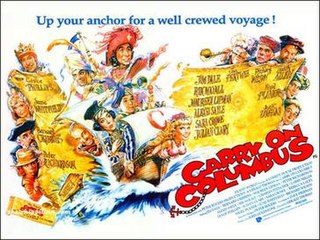
Carry On Columbus is a 1992 British comedy film directed by Gerald Thomas and starring Jim Dale, Bernard Cribbins, Maureen Lipman, Peter Richardson and many other British comic actors. It was written by Dave Freeman and John Antrobus.

Carry On Emmannuelle is a 1978 British comedy film, the 30th release in the series of 31 Carry On films (1958–1992). The film was to be the final Carry On for many regulars, including Kenneth Williams, Kenneth Connor, Joan Sims and Peter Butterworth. Jack Douglas is the only regular from this film to bridge the gap to Carry On Columbus. Beryl Reid, Henry McGee and Suzanne Danielle make their only appearances in the series here. The film featured a change in style, becoming more openly sexual and explicit. This was highlighted by the implied behaviour of Danielle's character, though she does not bare any more flesh than any other Carry On female lead. These changes brought the film closer to the then popular X-rated series of Confessions... comedies, or indeed the actual Emmanuelle films that it parodies. This film, as well as the initial release of Carry On England, were the only films in the series to be certified AA by the British Board of Film Censors, which restricted audiences to those aged 14 and over. The film was followed by the final installment of the series Carry On Columbus in 1992.

Carry On Loving is a 1970 British comedy film, the 20th release in the series of 31 Carry On films (1958–1992). It was directed by Gerald Thomas and features series regulars Sid James, Kenneth Williams, Charles Hawtrey, Joan Sims, Hattie Jacques, Terry Scott and Bernard Bresslaw alongside newcomers Richard O'Callaghan and Imogen Hassall. The dialogue veers toward open bawdiness rather than the evasive innuendo characteristic of the earlier films in the series. The film was followed by Carry On Henry in 1971.

Carry On Matron is a 1972 British comedy film, the 23rd release in the series of 31 Carry On films (1958–1992). It was released in May 1972. It was directed by Gerald Thomas and features series regulars Sid James, Kenneth Williams, Charles Hawtrey, Joan Sims, Hattie Jacques, Bernard Bresslaw, Barbara Windsor and Kenneth Connor. This was the last Carry On film for Terry Scott after appearing in seven films, and for Kenneth Cope after appearing in two.

That's Carry On! is a 1977 British comedy film, the 29th release in the series of 31 Carry On films (1958–1992). The film is a compilation of the highlights of most of the previous 28 films, and features series regulars Kenneth Williams and Barbara Windsor as co-presenters. It was Windsor's 10th and final appearance in the series. The idea for the film was inspired by Metro-Goldwyn-Mayer's popular That's Entertainment! series of documentaries. It was released in 1977 as a supporting feature to the Richard Harris film, Golden Rendezvous. The film was followed by "Carry On Emmannuelle" in 1978.




















